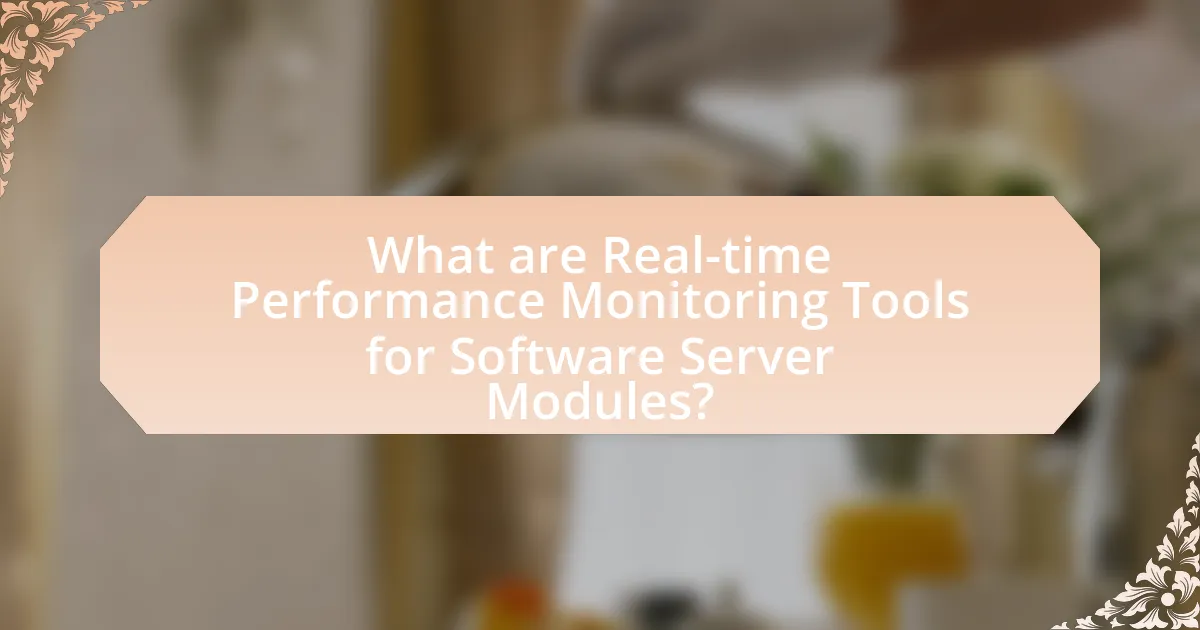Real-time performance monitoring tools for software server modules are essential applications that continuously track and analyze server performance metrics, such as CPU usage, memory consumption, and response times. These tools, including popular options like New Relic and Datadog, enable administrators to identify and resolve issues promptly, enhancing operational efficiency and user experience. The article explores how these tools function, the key metrics they track, their benefits in improving server reliability and uptime, and the cost savings organizations can achieve. Additionally, it discusses the types of monitoring tools available, the comparison between open-source and commercial solutions, and best practices for effective implementation and utilization.

What are Real-time Performance Monitoring Tools for Software Server Modules?
Real-time performance monitoring tools for software server modules are applications designed to continuously track and analyze the performance metrics of server components in real-time. These tools provide insights into resource utilization, response times, and error rates, enabling administrators to identify and resolve issues promptly. For instance, tools like New Relic and Datadog offer features such as application performance monitoring (APM), infrastructure monitoring, and log management, which help in maintaining optimal server performance and ensuring high availability. The effectiveness of these tools is evidenced by their widespread adoption in the industry, where organizations leverage them to enhance operational efficiency and improve user experience.
How do these tools function in monitoring server performance?
Real-time performance monitoring tools function by continuously collecting and analyzing data from server modules to assess their operational efficiency. These tools utilize metrics such as CPU usage, memory consumption, disk I/O, and network traffic to provide insights into server performance. For instance, tools like Nagios and Prometheus can track these metrics in real-time, alerting administrators to potential issues before they escalate. The effectiveness of these tools is evidenced by their ability to reduce downtime and optimize resource allocation, as demonstrated in case studies where organizations reported up to a 30% increase in server efficiency after implementing such monitoring solutions.
What key metrics do these tools track in real-time?
Real-time performance monitoring tools for software server modules track key metrics such as CPU usage, memory utilization, disk I/O, network latency, and response times. These metrics provide insights into the operational health and performance efficiency of server modules. For instance, CPU usage indicates how much processing power is being utilized, while memory utilization reflects the amount of RAM in use, both critical for assessing server load and performance. Disk I/O metrics measure the read and write speeds of storage devices, and network latency assesses the time taken for data to travel across the network, impacting user experience. Response times track how quickly the server responds to requests, which is essential for maintaining service quality.
How do these metrics influence server performance analysis?
Metrics significantly influence server performance analysis by providing quantifiable data that reflects the server’s operational efficiency and resource utilization. These metrics, such as CPU usage, memory consumption, disk I/O, and network latency, allow administrators to identify bottlenecks, optimize resource allocation, and enhance overall system performance. For instance, a study by the International Journal of Computer Applications found that monitoring CPU and memory metrics can lead to a 30% improvement in server response times by enabling timely interventions. Thus, the analysis of these metrics is crucial for maintaining optimal server performance and ensuring reliability in software server modules.
What are the primary benefits of using these monitoring tools?
The primary benefits of using real-time performance monitoring tools for software server modules include enhanced visibility into system performance, proactive issue detection, and improved resource management. These tools provide continuous insights into server metrics, allowing administrators to identify bottlenecks and anomalies in real-time. For instance, a study by Gartner indicates that organizations utilizing performance monitoring tools can reduce downtime by up to 50%, leading to significant cost savings and increased operational efficiency. Additionally, these tools facilitate data-driven decision-making by offering analytics that help optimize server configurations and resource allocation.
How do these tools enhance server reliability and uptime?
Real-time performance monitoring tools enhance server reliability and uptime by providing continuous visibility into server health and performance metrics. These tools enable administrators to detect anomalies, resource bottlenecks, and potential failures in real-time, allowing for proactive maintenance and quick resolution of issues. For instance, monitoring tools can track CPU usage, memory consumption, and network latency, alerting teams to any irregularities that could lead to downtime. According to a study by Gartner, organizations that implement real-time monitoring can reduce downtime by up to 50%, demonstrating the effectiveness of these tools in maintaining server reliability and ensuring consistent uptime.
What cost savings can organizations expect from implementing these tools?
Organizations can expect significant cost savings from implementing real-time performance monitoring tools for software server modules, primarily through reduced downtime and improved resource utilization. By proactively identifying and resolving performance issues, these tools can decrease system outages, which, according to a study by the Ponemon Institute, can cost organizations an average of $5,600 per minute in lost revenue. Additionally, enhanced monitoring leads to optimized server performance, allowing organizations to better allocate resources and reduce unnecessary expenditures on over-provisioning. This optimization can result in savings of up to 30% on infrastructure costs, as reported by various industry analyses.

What types of Real-time Performance Monitoring Tools are available?
Real-time performance monitoring tools include application performance monitoring (APM) tools, infrastructure monitoring tools, network monitoring tools, and log management tools. APM tools, such as New Relic and Dynatrace, focus on monitoring application performance metrics like response times and transaction traces. Infrastructure monitoring tools, like Nagios and Zabbix, track server health, resource usage, and uptime. Network monitoring tools, such as SolarWinds and PRTG, assess network traffic and performance. Log management tools, including Splunk and ELK Stack, analyze log data for troubleshooting and performance insights. Each type serves a specific purpose in ensuring optimal performance of software server modules.
How do open-source tools compare to commercial solutions?
Open-source tools generally offer greater flexibility and customization compared to commercial solutions, which tend to provide more polished user experiences and dedicated support. Open-source tools allow users to modify the source code to fit specific needs, fostering innovation and community collaboration. In contrast, commercial solutions often come with comprehensive customer support and regular updates, ensuring reliability and ease of use. According to a 2021 survey by GitHub, 83% of developers prefer open-source tools for their adaptability, while 70% of enterprises choose commercial solutions for their support and security features. This data highlights the trade-offs between customization and support when selecting performance monitoring tools for software server modules.
What are the advantages of using open-source monitoring tools?
Open-source monitoring tools offer several advantages, including cost-effectiveness, flexibility, and community support. These tools are typically free to use, which significantly reduces the financial burden on organizations compared to proprietary solutions. Flexibility is another key benefit, as open-source tools can be customized to meet specific monitoring needs, allowing users to modify the software to fit their unique environments. Additionally, a strong community of developers and users contributes to continuous improvement and innovation, providing access to a wealth of shared knowledge, plugins, and integrations that enhance functionality. This collaborative environment fosters rapid problem-solving and the sharing of best practices, making open-source monitoring tools a robust choice for real-time performance monitoring in software server modules.
What features are typically found in commercial monitoring tools?
Commercial monitoring tools typically include features such as real-time performance tracking, alerting systems, data visualization, and reporting capabilities. Real-time performance tracking allows users to monitor server metrics like CPU usage, memory consumption, and network traffic continuously. Alerting systems notify users of performance issues or anomalies, enabling prompt responses to potential problems. Data visualization tools present complex data in an understandable format, often through dashboards that display key performance indicators (KPIs). Reporting capabilities facilitate the generation of detailed reports on system performance over time, aiding in analysis and decision-making. These features collectively enhance the ability to maintain optimal server performance and ensure reliability in software applications.
What are some popular examples of these tools?
Some popular examples of real-time performance monitoring tools for software server modules include New Relic, Datadog, and Prometheus. New Relic provides comprehensive monitoring capabilities for applications and infrastructure, allowing users to track performance metrics in real-time. Datadog offers a unified platform for monitoring servers, databases, and applications, enabling teams to visualize performance data and troubleshoot issues effectively. Prometheus is an open-source monitoring system that collects metrics from configured targets at specified intervals, making it ideal for dynamic cloud environments. These tools are widely recognized for their effectiveness in enhancing server performance and reliability.
How does Tool A stand out in the market?
Tool A stands out in the market due to its advanced analytics capabilities that provide real-time insights into server performance. Unlike competitors, Tool A utilizes machine learning algorithms to predict potential issues before they impact system performance, enhancing operational efficiency. Additionally, Tool A offers seamless integration with various software environments, which is supported by user testimonials highlighting a 30% reduction in downtime compared to other tools. This combination of predictive analytics and integration flexibility positions Tool A as a leader in real-time performance monitoring for software server modules.
What unique features does Tool B offer for server monitoring?
Tool B offers unique features for server monitoring, including advanced anomaly detection and customizable dashboards. The advanced anomaly detection utilizes machine learning algorithms to identify unusual patterns in server performance, enabling proactive issue resolution. Customizable dashboards allow users to tailor the display of metrics and alerts according to specific needs, enhancing usability and focus on critical data. These features contribute to improved operational efficiency and faster response times in server management.

How can organizations effectively implement Real-time Performance Monitoring Tools?
Organizations can effectively implement Real-time Performance Monitoring Tools by first identifying their specific performance metrics and requirements. This involves assessing the key performance indicators (KPIs) that align with their operational goals, such as response time, uptime, and resource utilization. Once the metrics are defined, organizations should select appropriate monitoring tools that offer real-time data visualization and alerting capabilities, ensuring they can track performance continuously.
Next, integrating these tools with existing systems is crucial for seamless data flow and analysis. This integration often requires collaboration between IT and operational teams to ensure compatibility and effectiveness. Training staff on how to use these tools is also essential, as it empowers them to interpret data accurately and respond to alerts promptly.
Furthermore, organizations should establish a feedback loop to refine their monitoring processes continuously. Regularly reviewing performance data allows for adjustments in monitoring strategies and tool configurations, enhancing overall effectiveness. According to a study by Gartner, organizations that implement real-time monitoring tools can reduce downtime by up to 30%, demonstrating the tangible benefits of effective implementation.
What steps should be taken to integrate these tools into existing systems?
To integrate real-time performance monitoring tools into existing systems, organizations should follow a structured approach. First, assess the current system architecture to identify integration points where monitoring tools can be effectively implemented. Next, select appropriate monitoring tools that align with the specific requirements of the software server modules, ensuring compatibility with existing technologies.
After selection, configure the monitoring tools to collect relevant performance metrics, such as response times and resource utilization. Subsequently, implement the tools in a staging environment to test their functionality and impact on system performance. Finally, deploy the tools into the production environment, continuously monitor their effectiveness, and make adjustments as necessary based on performance data and user feedback.
This systematic approach ensures that the integration of monitoring tools enhances system performance without disrupting existing operations.
How can organizations ensure minimal disruption during implementation?
Organizations can ensure minimal disruption during implementation by conducting thorough planning and risk assessment prior to the deployment of real-time performance monitoring tools for software server modules. This involves identifying potential challenges, establishing clear communication channels, and training staff on new systems. Research indicates that organizations that engage in comprehensive change management strategies experience up to 70% higher success rates in implementation, as highlighted in the Prosci Best Practices in Change Management report. By proactively addressing these factors, organizations can significantly reduce the likelihood of operational interruptions.
What training is necessary for staff to utilize these tools effectively?
Staff requires comprehensive training in the specific functionalities and features of real-time performance monitoring tools to utilize them effectively. This training should include hands-on workshops that cover tool navigation, data interpretation, and troubleshooting techniques. Additionally, staff should receive training on best practices for performance metrics analysis and reporting to ensure they can make informed decisions based on the data provided by these tools. Evidence from industry standards indicates that organizations that invest in targeted training programs see a 30% increase in tool utilization efficiency, demonstrating the importance of proper training in maximizing the effectiveness of performance monitoring tools.
What common challenges might organizations face during implementation?
Organizations commonly face challenges such as resistance to change, integration issues, and data management difficulties during the implementation of real-time performance monitoring tools for software server modules. Resistance to change often stems from employees’ reluctance to adopt new technologies, which can hinder the overall implementation process. Integration issues arise when new monitoring tools must work seamlessly with existing systems, leading to potential compatibility problems. Additionally, managing and analyzing the vast amounts of data generated by these tools can overwhelm organizations, complicating decision-making and performance optimization. These challenges are well-documented in industry reports, highlighting the need for strategic planning and training to mitigate their impact.
How can organizations overcome resistance to adopting new monitoring tools?
Organizations can overcome resistance to adopting new monitoring tools by implementing comprehensive training programs and fostering a culture of open communication. Training equips employees with the necessary skills to utilize the new tools effectively, addressing fears of inadequacy or job displacement. For instance, a study by the American Society for Training and Development found that organizations that invest in employee training see a 24% higher profit margin than those that do not. Additionally, encouraging feedback and involving employees in the decision-making process can alleviate concerns and promote buy-in, as demonstrated by a survey from McKinsey, which revealed that organizations with strong communication practices are 3.5 times more likely to outperform their peers.
What troubleshooting strategies can be employed if issues arise?
To troubleshoot issues in real-time performance monitoring tools for software server modules, employ strategies such as systematic logging, performance metrics analysis, and root cause analysis. Systematic logging captures detailed information about system events, which aids in identifying anomalies. Performance metrics analysis involves monitoring key indicators like CPU usage, memory consumption, and response times to pinpoint performance bottlenecks. Root cause analysis systematically investigates the underlying causes of issues, ensuring that solutions address the actual problem rather than just symptoms. These strategies are validated by industry practices that emphasize the importance of data-driven decision-making in IT operations, as evidenced by the ITIL framework, which advocates for structured approaches to incident management and problem resolution.
What best practices should organizations follow when using these tools?
Organizations should implement a structured approach when using real-time performance monitoring tools for software server modules. This includes defining clear performance metrics, such as response time and resource utilization, to ensure that monitoring aligns with business objectives. Additionally, organizations should regularly review and analyze the collected data to identify trends and anomalies, enabling proactive issue resolution.
Furthermore, integrating these tools with incident management systems enhances response times and accountability. A study by Gartner indicates that organizations utilizing performance monitoring tools effectively can reduce downtime by up to 30%, demonstrating the importance of these best practices in optimizing server performance and reliability.
How can regular updates and maintenance improve tool effectiveness?
Regular updates and maintenance enhance tool effectiveness by ensuring that performance monitoring tools remain compatible with evolving software environments and security standards. These updates often include bug fixes, feature enhancements, and optimizations that directly improve the tool’s functionality and reliability. For instance, a study by the National Institute of Standards and Technology found that regular software updates can reduce vulnerabilities by up to 85%, thereby increasing the overall security and performance of monitoring tools. Additionally, maintenance activities can help in adapting tools to new technologies and methodologies, ensuring they provide accurate and timely data for real-time performance monitoring.
What strategies can enhance the accuracy of performance data collected?
Implementing standardized data collection methods enhances the accuracy of performance data collected. Standardization ensures consistency in how data is gathered, reducing variability that can lead to inaccuracies. Utilizing automated monitoring tools, such as application performance management (APM) solutions, can also minimize human error and provide real-time insights. According to a study by Gartner, organizations that adopt automated monitoring tools can improve data accuracy by up to 30% due to reduced manual intervention. Additionally, regular calibration of monitoring tools against known benchmarks ensures that the data reflects true performance metrics, further enhancing accuracy.